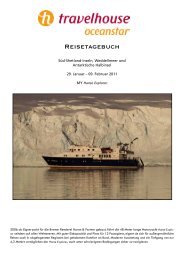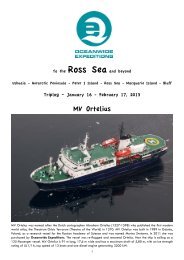ÐÐ ÐÎÎΡÐÐ ÐÐÐ¥ÐÐÐ - Spitzbergen
ÐÐ ÐÎÎΡÐÐ ÐÐÐ¥ÐÐÐ - Spitzbergen
ÐÐ ÐÎÎΡÐÐ ÐÐÐ¥ÐÐÐ - Spitzbergen
Create successful ePaper yourself
Turn your PDF publications into a flip-book with our unique Google optimized e-Paper software.
Most of us walked up a ridge and down to the shore on the other side of Aitcho Island, which was just<br />
a narrow Isthmus at this site. The strength of the wind was incredible on top of the ridge, and groups<br />
of Penguins were seeking shelter just under the ridge.<br />
Finally Rolf decided it was unwise to stay any longer, and after a somewhat choppy ride we were soon<br />
back on board the Grigoriy Mikheev to warm up in the bar. The windspeed at the ship had picked up to<br />
more than 20 m/s – a solid force 9 on the Beaufort scale! During our stay ashore, the ship's anchor had<br />
been dragging across the ground for almost half a mile and our Captain was quite relieved when the<br />
anchor was up again and the ship under<br />
steam.<br />
We were heading for Deception Island,<br />
about 50 nautical miles from here,<br />
hoping for better conditions there as it<br />
was pretty clear that Zodiac operations<br />
were not an option in these conditions.<br />
The weather chart looked quite<br />
frightening, featuring a strong lowpressure<br />
system – we were glad not to be<br />
out in the Drake Passage anymore! And<br />
the Barograph showed an interesting<br />
curve, that could best be described as a<br />
near-vertical drop.<br />
It was shortly after 15:00 that we passed below Neptune’s Bellows, the U-shaped bite in the cliffs<br />
from where, in 1820, the young Nathaniel Palmer, climbing for birds’ eggs, looked east and saw more<br />
land – which would turn out to be the Antarctic Peninsula, though he never claimed it as continental<br />
land; he was not an explorer, but a sealer. Gerlache would eventually name this part of the mainland<br />
Palmer Land. Captain Khoroshaylov took us safely through the channel between Cathedral Crags,<br />
towering to our right, and the hidden menace of Ravn Rock to our left, which had snared the whaler<br />
Southern Hunter still visible on the shore on our port side, after running aground on 21 December<br />
1956. Deception Island itself was named by Palmer who had nearly given up being able to land when<br />
he found the entrance into Port Foster, a natural harbour almost as big as Rio de Janeiro’s.<br />
A turn to starboard brought us into Whaler’s Bay. Deception is a microcosm of the different phases of<br />
use and occupation of Antarctica. First came sealers, and then early scientists and whalers, who left the<br />
rusting remains of Hektor Whaling Station in the centre of the bay. The first Antarctic flights were<br />
made in 1929 when Hubert Wilkins flew a Lockheed Vega over the Peninsula. The aircraft hangar to<br />
the left of the other relics was built later by the British Antarctic Survey. More scientists were hot on<br />
their heels, and later spies and tourists. The first international football match in the last continent was<br />
played here: the English<br />
crew of HMS Snipe beat the<br />
Argentine crew of the<br />
Seaver by 1-0: one of the<br />
more peaceful disputes<br />
between the two countries.<br />
The drama of the scenery<br />
was unmissable, and we<br />
savoured the excitement of<br />
navigating across one of<br />
Antarctica’s most famous<br />
locations, a caldera which is<br />
still volcanically active.<br />
6
















